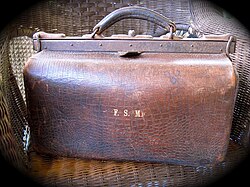

A portmanteau is a piece of luggage, usually made of leather and opening into two equal parts. Some are large, upright, and hinged at the back and enable hanging up clothes in one half, [1] while others are much smaller bags (such as Gladstone bags) with two equally sized compartments. [2]
Contents
The word derives from the French word portemanteau (from porter, "to carry", and manteau, "coat") which nowadays means a coat rack but was in the past also used to refer to a traveling case or bag for clothes. [3] [4]
